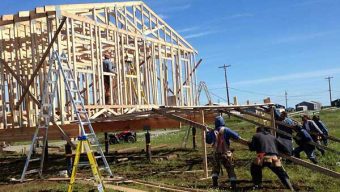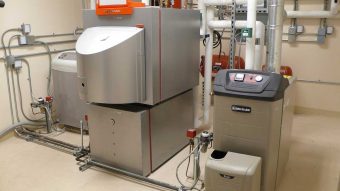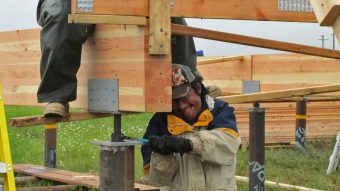Boiler Basics
Today’s boilers offer a wide range of customized options to maximize efficiency, and Alaska’s climate justifies paying for the most efficient system possible up front, since the extra money will be paid back several times during the system’s operating lifetime. Because of the many variables involved in selecting a boiler for your home, there is no perfect system that works for everyone. Ensure that whomever you hire to provide, install, or retrofit a system is aware of the fine details and performs the necessary calculations. These calculations are especially important given the sophisticated components and sensors required by today’s most efficient boilers.
First, the basics. Boilers heat water, which is pumped through a system of pipes and radiators that conduct heat into the rooms of your house. Boiler efficiency is measured by annual fuel utilization efficiency (AFUE). There is some debate over AFUE ratings because they do not account well for heat loss from boilers that maintain operating temperatures throughout the day. Also, AFUE does not measure heat loss from boilers or pipes that are located outside of insulated living spaces such as attics, basements, and garages. AFUE will not account for room heat that escapes out open flues. Nevertheless, AFUE remains the basic standard.
Most boilers are connected to a baseboard loop system, which is really just a series of low-profile radiators that distribute heat along the length of a pipe in a room before returning water to the boiler. A single thermostat triggers heating cycles. New boilers are required to attain a minimum AFUE rating of 80 percent, which means 80 percent of the heat generated is useful heat instead of energy that escapes up the chimney.
An alternative to baseboard heating is a radiant floor system. In this scenario, loops of pipes are placed into your subfloor to heat from the floor level up. This arrangement can produce more even heat throughout a room than baseboards because the whole floor space can be crisscrossed with pipes. Also, a radiant floor system has the benefit of producing more thermal comfort–fewer arguments over whether the room is too hot or cold–because more of the heat is felt in the living space instead of rising to the ceiling.
The next major decision is whether to install a standard combustion boiler or a condensing boiler. Condensing boilers generate more useful heat by extracting energy from flue gas and condensing the water vapor created by the combustion process. This process can achieve AFUE ratings of 90 percent or greater. Since condensing boilers must operate at lower temperatures for maximum efficiency, they perform best with heat emitters such as radiant floors that also utilize lower temperatures.
Another option is a low-mass boiler that purges system heat at the end of each operating cycle to minimize how much heat is lost to the boiler room and up the flue. Sealed combustion systems can work with different types of boilers and may offer further fuel savings; however they require an exterior air source and a dedicated vent.
A boiler fitted with an outdoor reset, which senses outdoor temperatures, can increase efficiency by reducing the boiler system’s water temperature as low as possible.
Lastly, a few tips on sizing your boiler. Whether you’re buying new or upgrading, it’s critical the boiler is the right size for your home. Correctly sized boilers operate more efficiently and are able to keep your house at a comfortable temperature. A boiler that is too small will not be able to produce enough heat in the winter months, and an oversized boiler will cycle on and off, wasting fuel, just like a car driving in stop-and-go traffic. Here are thee ways to know if your current boiler is the correct size:
- The rule-of-thumb: On the coldest day of the year, your boiler should run pretty much nonstop to keep the house at the set temperature. Think of it as a car driving on the highway, getting good mileage since it doesn’t have to start and stop. If your boiler is running nonstop but your house does not stay warm, the boiler is undersized. On the other hand, if you find your boiler cycling on and off during the coldest week in January, you should consider getting a smaller boiler.
- The calculations method: To determine what size heating appliance you will need, in addition to finding information about other possible energy upgrades, consider signing up for an energy rating. An energy rater will look at your entire house, measuring the air leakage rate with depressurization from doors and windows, checking insulation levels, assessing your heating system and checking for drafts. They will plug this information into a program (called AKWarm in Alaska) that calculates energy ratings. In a few weeks, you will receive a rating in the mail that includes information on your heating needs and ways to improve the efficiency of your home.
- Do-it-yourself: The rating software AKWarm is available for free online. If you are computer savvy and have a few hours to gather information on your house, you can use AKWarm to calculate your own unofficial energy rating.





